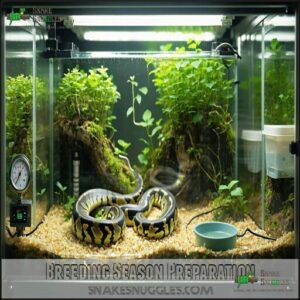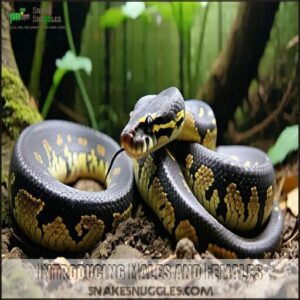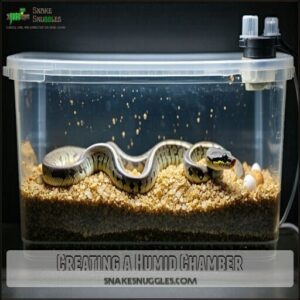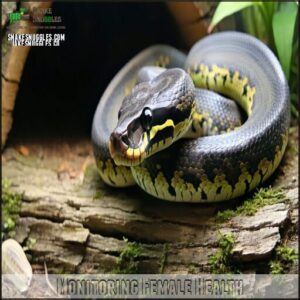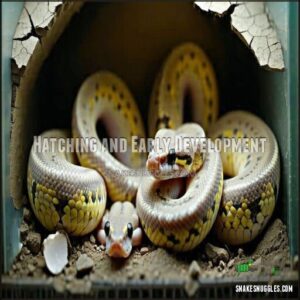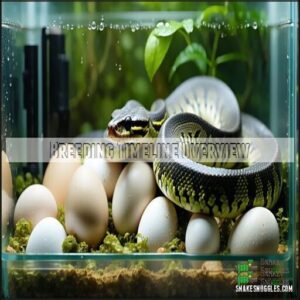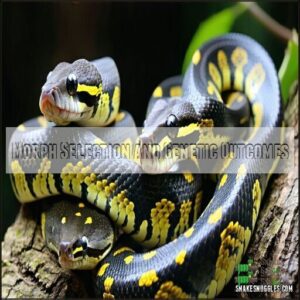This site is supported by our readers. We may earn a commission, at no cost to you, if you purchase through links.
 Breeding ball pythons takes patience and planning, but it’s incredibly rewarding.
Breeding ball pythons takes patience and planning, but it’s incredibly rewarding.
Start by cooling their enclosures slightly during winter months to mimic natural conditions—this triggers breeding behavior.
Pair your male and female in late fall or early winter, watching for courtship signs like tail wrapping.
After successful mating, the female will ovulate, followed by egg-laying in 30–50 days.
Provide a humid nesting box and incubate eggs at 88–90°F for about 55–60 days.
Document each stage with pictures to track progress and troubleshoot.
Breeding isn’t just science—it’s part art, part waiting game.
Curious about morph genetics or hatchling care? Stay tuned!
Table Of Contents
- Key Takeaways
- How to Breed a Ball Python With Timeline and Pictures?
- Breeding Season Preparation
- Temperature Regulation for Breeding
- Breeding Enclosure Setup
- Egg Laying and Incubation
- Monitoring Female Health
- Candling and Egg Management
- Hatching and Early Development
- Breeding Timeline Overview
- Morph Selection and Genetic Outcomes
- Frequently Asked Questions (FAQs)
- What is the timeline for ball pythons?
- How to tell if your ball python is ready to breed?
- How to breed ball pythons for beginners?
- How do pythons mate step by step?
- How to identify a ball python’s gender accurately?
- Can ball pythons breed with different python species?
- What are common health issues in breeding ball pythons?
- How to enhance ball python fertility naturally?
- What legal considerations exist for breeding ball pythons?
- What should I do if the eggs go moldy?
- Conclusion
Key Takeaways
- Start by cooling the enclosure to mimic seasonal changes, which triggers breeding behavior and prepares your snakes for mating.
- Introduce the male to the female’s enclosure during the evening, and watch for tail wrapping as a sign of successful courtship.
- Provide a humid nesting box for the female to lay eggs, then incubate them at 88–90°F with 80–90% humidity for 55–60 days.
- Document every stage, from ovulation to hatching, with pictures to track progress and identify potential issues.
How to Breed a Ball Python With Timeline and Pictures?

Commence on your ball python breeding adventure with a roadmap to success!
Ethical breeding starts with understanding the intricate dance of python reproduction.
Whether you’re a novice or seasoned reptile enthusiast, mastering the python breeding timeline requires patience, knowledge, and precision.
Your journey will traverse through carefully timed courtship, strategic genetic pairing, and careful environmental management.
Master the art of ball python breeding through patience, precision, and a deep understanding of nature’s rhythms.
By focusing on genetic diversity and avoiding common beginner mistakes, you’ll transform your passion into a rewarding breeding experience that contributes to the fascinating world of ball python morphs.
Breeding Season Preparation
You’ll need to carefully prepare your ball pythons for breeding season, which starts with understanding their specific environmental and health requirements.
By creating the right conditions and closely monitoring your snakes’ weight, behavior, and readiness, you’ll set the stage for a successful and responsible breeding process.
Optimal Season Timing
The python breeding season dances to a rhythmic annual beat, stretching from January through December, with most ball pythons naturally laying eggs between April and June.
Your breeding timeline depends on precise synchronization of seasonal triggers.
Consider weight milestones critical: males need around 700 grams (typically at 8 months), while females require 1,200 grams (between 2-3 years old). Think of it like training athletes – readiness matters more than age.
Regional variations play a significant role in breeding success. Some breeders pair snakes year-round, while others strictly follow traditional seasonal windows.
Your success hinges on understanding individual snake behaviors and environmental conditions. Barometric pressure changes and temperature fluctuations can influence clutch frequency and hatching success.
Monitoring your pythons’ unique patterns becomes paramount. Each snake responds differently to breeding stimuli, making flexibility and keen observation your greatest tools in this reproductive journey.
Feeding and Monitoring
When timing your ball python breeding season, nutrition becomes your secret weapon. Keep your snakes in peak condition with strategic feeding protocols that maximize reproductive potential.
Your breeding strategy should include:
- Weekly weight checks that tell a story of readiness
- Precise prey sizing matching snake’s developmental stage
- Consistent tracking of feeding responses
- Monitoring body condition after each meal
- Documenting subtle changes in appetite
Feeding frequency matters more than you might think. Adult males need meals every 10-14 days, while females require carefully managed nutrition to maintain that critical 1,500+ gram threshold.
Watch for seasonal appetite shifts—they’re totally normal during ball python breeding cycles.
Your careful record-keeping transforms random observations into a roadmap for successful breeding ball pythons.
Temperature Regulation for Breeding
You’ll need to master temperature regulation to successfully breed ball pythons, as it’s the secret sauce that triggers their reproductive cycle.
By carefully manipulating temperatures and creating seasonal variations, you’ll mimic their natural breeding environment and increase your chances of snake romance.
Cooling Process
Once you’ve set the stage for breeding, it’s time to master the cooling process.
Start your temperature cycling in late August, gently lowering temperatures over 4-6 weeks until you hit the sweet spot of 55-60°F.
Maintain a strategic temperature gradient: keep the hot end at 85-90°F and the cool end at 75-80°F.
Monitor your snake closely during this winter simulation. Watch for stress signals like unusual lethargy or appetite changes.
For precise control, consider a specialized reptile cooler.
Adjust temperatures carefully, mimicking nature’s subtle seasonal shift.
Brumation Guidelines
When cooling your ball python for breeding, forget true brumation.
These tropical reptiles need a gentle temperature simulation, not extreme cold.
Lower your enclosure’s daytime temps to around 75°F with a warm spot between 82-85°F – mimicking natural breeding cycles without risking their health.
Watch for subtle shifts in behavior: reduced activity or occasional food strikes signal your snake’s breeding readiness.
This careful temperature manipulation triggers hormonal changes, preparing your ball python for potential mating without subjecting them to harsh environmental stress.
Your keen observation is key to successful breeding.
Breeding Enclosure Setup
You’ll want to create a breeding setup that mimics the natural environment of ball pythons, guaranteeing prime conditions for successful mating.
Your enclosure should provide ample space, strategic hiding spots, and precise temperature and humidity controls to encourage courtship and reduce stress for both male and female snakes.
Introducing Males and Females
Once your temperatures are perfect, it’s time to introduce your male and female ball pythons.
Start by placing the male ball python into the female’s enclosure during the evening, as they’re more active at night. This initial introduction is all about observing their responses.
Watch for these signs of successful python mating behavior:
- The male shows interest through tongue flicking and gentle nudges.
- The female remains calm, showing no aggression or defensive posturing.
- Both pythons appear relaxed, with no signs of stress like hissing or rapid movements.
To prevent fighting, always introduce a well-rested male after giving him a week’s break from prior breeding attempts.
A suitable ball python habitat is key for successful breeding.
Keep a separate enclosure ready in case things don’t go smoothly.
With patience and proper python breeding stimulation, you’ll set the stage for success!
Observing Courtship Behaviors
Breeding ball pythons is like watching a slow dance unfold.
Male posturing, such as chin rubbing or belly pressing, signals interest, while female receptivity determines success. Initial interactions might seem tense, but they usually ease as the snakes settle into breeding positions.
Mating duration can last hours or even days—patience is key!
Courtship behaviors thrive in ideal conditions, so maintain proper humidity and temperature.
A proper setup requires a quality ball python enclosure.
Observing python breeding behavior is fascinating and fundamental for your breeding timeline. Pictures help capture these memorable moments!
Egg Laying and Incubation
When your ball python is ready to lay eggs, it’s time to prepare a safe, humid nesting spot to keep her comfortable.
Proper incubation conditions are critical to guarantee healthy hatchlings, so don’t skimp on monitoring temperature and humidity—it’s like babysitting, but for eggs!
Creating a Humid Chamber
Think of your humid chamber as a luxury spa for your ball python eggs—comfort is key!
Start with a sturdy plastic tub and line it with 3-4 inches of damp vermiculite or perlite to maintain best moisture levels.
Keep humidity levels between 80-90%, as this guarantees proper egg incubation and prevents drying out.
Add small, evenly spaced ventilation holes to promote airflow—stale air is no friend to hatchling success.
Place the tub in a quiet, draft-free spot with temperature stability around 82-86°F.
Avoid direct sunlight to prevent overheating or mold growth.
- Humidity Materials: Damp vermiculite or perlite.
- Ventilation Importance: Balanced airflow prevents stale air.
- Temperature Stability: Consistent warmth ensures healthy development.
Temperature and Humidity Control
Mastering temperature control and humidity levels is the backbone of successful ball python egg incubation.
Use a reliable incubator to maintain a steady heat gradient of 82-86°F, ensuring no area exceeds 95°F.
Keep humidity levels between 80-90% to prevent egg shrinkage—think of it as mimicking a tropical spa for your clutch!
Daily monitoring systems, like digital thermometers and hygrometers, are essential for catching fluctuations. Place probes at egg level for accuracy.
Boost moisture with misting systems or damp substrate, but don’t overdo it—ventilation needs are just as critical.
Remember to maintain proper humidity levels to support healthy egg development.
Monitoring Female Health
Keeping an eye on your female ball python’s health is key during breeding to guarantee she stays strong and stress-free.
From ovulation to post-laying recovery, you’ll need to spot changes quickly—because nobody wants a grumpy, unwell snake!
Signs of Ovulation
Spotting ovulation in your female ball python is like catching nature’s green light for breeding. You’ll notice clear breeding signs if you know what to look for.
- Mid-Body Swelling: A gravid female will show a distinct bulge about two-thirds down her body. It’s most visible when she stretches out.
- Physical Changes: Her scales may take on a shiny, iridescent glow, or her color might lighten slightly—almost like she’s dressing up for the occasion.
- Female Behavior: Increased restlessness is common. She may frequently reposition herself or gravitate toward cooler spots in her enclosure, signaling preovulation prep.
These fertile indicators confirm ovulation is underway, setting the stage for successful breeding.
Keep observing for more post-ovulation care cues!
Pre and Post-Laying Care
Caring for your female ball python during egg laying is critical to her health and the success of her clutch.
Watch for gravid behavior, like restlessness or food refusal, as she nears laying. Guarantee proper nesting preparation by providing a box with damp sphagnum moss.
Once she lays the eggs, separate them within 12 hours for ball python egg incubation.
After laying, focus on post-laying nutrition by offering small meals 24 hours later. She’ll need 2-3 weeks to recover, so keep her environment quiet and stress-free.
Monitor her closely during this time to guarantee she regains weight and energy. A healthy female means better hatchling health and smoother python breeding timelines!
Candling and Egg Management
You’ll need to candle the eggs to check for fertility and make certain your clutch stays healthy.
It’s like shining a flashlight on a mystery—fertile eggs glow with veins, while infertile ones need quick removal to avoid trouble.
Identifying Fertility
Spotting fertile eggs is easier with candling techniques.
Hold each egg against a bright light, and you’ll notice fertility indicators like a reddish or orange glow with vein visibility—imagine a tiny roadmap inside. These veins confirm healthy embryonic growth.
Infertile eggs, or slugs, lack these signs, appearing yellowish or dull green instead.
Don’t let odd shapes or minor egg abnormalities fool you; fertile eggs vary in appearance but often hatch fine. For successful incubation, maintaining optimal humidity levels is also critical.
- Fertile signs: Bright glow with visible veins.
- Slug identification: No veins, dull color.
- Candling tip: Use a flashlight for clarity.
- Egg abnormalities: Often harmless.
Handling Infertile Eggs
Spotting infertile eggs early safeguards clutch health and prevents mold growth.
Candling helps identify slugs—clear or yellowish eggs without visible veins.
Remove these promptly to avoid contamination. False positives can happen, so double-check before disposal.
Mold prevention is key; separate bad eggs to protect embryo formation in fertile ones.
Even with perfect egg development, occasional hatch failures occur, so don’t sweat it—breeding ball pythons always keeps you on your toes!
Hatching and Early Development
When your ball python eggs finally start to dimple and soften, you know hatching is just around the corner.
It’s an exciting moment, but don’t rush—those tiny hatchlings need time to break free on their own!
Incubation Duration
The incubation duration for ball python eggs typically spans 55-65 days, a period where patience and precision are your best friends.
Keep your incubator temperature steady between 88°F and 90°F, with humidity locked at 90%—this combo is non-negotiable for healthy egg development. A reliable setup guarantees proper growth and hatch rates, so don’t skimp on quality equipment. Optimal humidity levels are essential for successful hatching.
Leave the eggs in their original position—nature’s GPS has them perfectly aligned.
Around day 50, you’ll spot dimpling, a sign that hatching is near.
- The stakes are high: temperature swings can harm embryos.
- Humidity matters: too low, and eggs shrink.
- Every day counts: monitor closely.
- Success feels amazing!
Hatchling Care
Once your python hatchlings emerge, it’s time to focus on their care. These tiny snakes are fragile but full of potential.
- First Feeding: Offer frozen-thawed rat pups or mouse fuzzies every 5-7 days. Don’t rush—let them settle before meals.
- Enclosure Setup: Use tubs with lightly misted paper towels to maintain humidity. Add a water dish and hiding spots.
- Shedding Issues: Monitor humidity to avoid stuck sheds. Hatchlings shed a few days after hatching—don’t handle until then.
- Health Monitoring: Track weight, behavior, and eating habits. Early signs of trouble? Adjust care or consult an expert.
Hatchling care guarantees strong neonate development!
Breeding Timeline Overview
Breeding ball pythons follows a detailed timeline, from ovulation to hatching, requiring careful planning and observation.
You’ll track each stage, ensuring your snakes stay healthy while their eggs develop into tiny, slithering hatchlings—it’s as rewarding as it sounds!
It’s as rewarding as it sounds!
From Ovulation to Hatching
Once your female shows gravid behavior and lays her eggs, gently relocate them to an incubator set at 85°F with 90% humidity.
Proper egg placement is key—keep them upright and undisturbed to prevent incubation problems.
Over the 52-60 days of ball python egg incubation, monitor for mold or infertile eggs.
Hatchlings emerge using their egg tooth, a tiny built-in tool for breaking free.
Celebrate this moment, but prepare for post-hatch care to guarantee these new additions thrive from day one.
Documenting Developmental Stages
Capturing the journey of breeding ball pythons is like creating a scrapbook of life’s little miracles.
Documenting embryo development, hatchling growth, and shedding patterns helps you track progress while identifying genetic markers and behavioral changes.
Use photos and notes to map their python breeding timeline and monitor ball python egg incubation milestones. This record-keeping guarantees healthy python hatchlings and supports future breeding efforts. Temperature cycling is also a key factor in successful breeding.
- Track shedding patterns to spot growth spurts.
- Photograph genetic markers for morph identification.
- Log behavioral changes during incubation.
- Record hatchling growth weekly.
Morph Selection and Genetic Outcomes
Choosing the right morphs isn’t just exciting—it’s like planning a genetic puzzle with endless possibilities.
By understanding how traits pass down, you’ll increase your chances of creating stunning patterns and colors in your hatchlings.
Understanding Morph Variability
Exploring morph variability in ball python genetics is like revealing a treasure chest of possibilities.
Morph variability unlocks endless creative potential, blending science and art to craft stunning ball python patterns and colors.
Through selective breeding, you can create stunning ball python morphs showcasing unique patterns, colors, and traits.
Morph genetics often involve recessive traits, dominant genes, or co-dominance, leading to fascinating combinations like Albino, Piebald, or even Scaleless morphs.
Wild ball pythons may stick to their earthy tones, but captive breeding liberate endless creative potential.
With careful morph selection, your breeding program can produce visually striking snakes that stand out, proving science and art blend beautifully in ball python morphs breeding.
Understanding genetic color inheritance is key to predicting breeding outcomes.
Potential for New Morph Combinations
Breeding ball pythons offers a creative playground to design stunning snake morphs. With ball python genetics, you can predict visual outcomes and experiment with designer morphs responsibly. Morph recessiveness and genetic probabilities guide your choices, ensuring healthy results.
- Pair morphs with complementary traits for vibrant patterns.
- Use tools like genetic calculators to predict outcomes.
- Avoid overbreeding rare morphs to maintain breeding ethics.
- Document results for future reference.
- Start with established python morphs before tackling complex snake morphs.
Your next masterpiece might just slither into the spotlight!
Frequently Asked Questions (FAQs)
What is the timeline for ball pythons?
Think of ball python breeding as a slow dance.
Cooling starts in fall, pairing happens late winter, eggs are laid by spring, and hatchlings emerge 55-60 days later.
Patience and timing are your best partners.
How to tell if your ball python is ready to breed?
Your ball python is ready to breed if it’s healthy, well-fed, and at least 2-3 years old.
Females should weigh over 1,500 grams, males 700 grams.
Watch for increased activity and willingness to mate.
How to breed ball pythons for beginners?
Breeding ball pythons isn’t rocket science, but it’s no walk in the park either.
Start with healthy, mature snakes, control temperatures precisely, mimic seasonal changes, and guarantee patience—success takes time, dedication, and proper care.
How do pythons mate step by step?
To mate pythons, introduce a healthy male into the female’s enclosure during her breeding cycle.
They’ll align tails, the male inserts his hemipenes, and copulation lasts hours to days.
Don’t disturb them—patience pays off!
How to identify a ball python’s gender accurately?
Funny how nature works, right?
To identify a ball python’s gender, gently probe the cloaca.
Males have deeper pockets with 8 subcaudal scales, while females show shallower pockets and only 4 scales. Males have deeper pockets with 8 subcaudal scales, while females show shallower pockets and only 4 scales.
Can ball pythons breed with different python species?
No, ball pythons can’t breed with other python species.
Their genetic differences prevent interbreeding.
It’s like trying to mix apples and oranges—cool in theory, but nature’s rules say, “Not happening!”
Stick to same-species pairings.
What are common health issues in breeding ball pythons?
Breeding ball pythons isn’t all sunshine and scales.
You’ll face risks like egg-binding, respiratory infections, stress-induced anorexia, and reproductive organ injuries.
Always monitor their health closely and consult a reptile vet at the first sign of trouble.
How to enhance ball python fertility naturally?
Boost fertility by ensuring proper nutrition, maintaining stable humidity (60-70%), and mimicking seasonal cooling.
Give females brumation-like rest and stimulate males with rival scents.
Healthy, stress-free snakes are your secret weapon for successful breeding!
What legal considerations exist for breeding ball pythons?
Like traversing a maze, breeding ball pythons requires legal awareness.
Research permits, local wildlife laws, and animal welfare regulations.
Avoid selling wild-caught snakes, follow ethical practices, and keep records to guarantee compliance and avoid hefty fines.
What should I do if the eggs go moldy?
If eggs go moldy, remove the affected ones immediately to prevent spreading.
Mold usually won’t harm neighboring healthy eggs, but keep humidity balanced and monitor closely.
A little TLC goes a long way here!
Conclusion
Breeding ball pythons isn’t rocket science, but patience is key.
By following this timeline and documenting each stage with pictures, you’ll stay on track and troubleshoot effectively.
Cooling enclosures, observing courtship, and managing egg incubation at 88–90°F all play important roles.
Keep an eye on your female’s health and provide proper care before and after laying.
With planning, you’ll enjoy the reward of healthy hatchlings and maybe even discover exciting new morph combinations.
- https://snaketracks.com/ball-python/
- https://ask.extension.org/kb/faq.php?id=568349
- https://reptifiles.com/ball-python-care-guide/ball-python-humidity-temperatures/
- https://www.zillarules.com/information/care-sheets/ball-python
- https://bobclark.com/blogs/articles/ball-python-primer?srsltid=AfmBOoo6Fl4tEeAeg07Vlu6K315A65-QMF8vjM_QWZMvreTXKz2K-2z6

